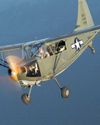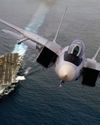يحاول ذهب - حر
F7F Tigercats Over North Korea
October 2019
|Flight Journal
Grumman's svelte postwar killer

The end of the war with Japan happened so fast that the U.S. effort to complete a twin-engine fighter was slowed. The Navy tried Grumman’s F7F Tigercat and found that it was too heavy and its high landing speed caused the aircraft to fail carrier-suitability trials. Therefore, the Marines decided to try it and said that it would work perfectly from its land bases. The only contenders for their types of missions were the F-82 Twin Mustang and the F7F Tigercat. They had both been designed to fly long-range escort on the B-29 Superfortresses on their bombing raids to Japan. Both aircraft were in production and ready for service shortly after the war ended, so they were available when the Korean War started in late June 1950. The F-82 was already in inventory in the Far East. Marine night fighter units, however, were alerted that they would be taking the Tigercat into battle.
A New War for Marine Aviators
The first Marine unit to arrive after the invasion at Inchon was VMF(N)-542, under the command of Lt. Col. Max Volcansek. They loaded their 24 F7Fs on the USS Cape Esperance and headed for Japan on August 26, 1950. Two months had passed since the North Koreans invaded the south, so their timing was perfect. The aircraft had twin engines and tricycle landing gear, and seen from certain angles, it was a beautiful airframe that exuded a tremendous “killer” presence. The armament it carried included four 20mm cannon mounted in the wing roots with 800 rounds of ammunition. The F7F had provisions for eight 5-inch (12.7cm) high-velocity aircraft rockets (HVAR) or three 11.75-inch Tiny Tim air-to-ground rockets. On top of this, it had a speed of 435mph, a rate of climb at 3,500 feet per minute, and a range of 1,200 miles.
هذه القصة من طبعة October 2019 من Flight Journal.
اشترك في Magzter GOLD للوصول إلى آلاف القصص المتميزة المنسقة، وأكثر من 9000 مجلة وصحيفة.
هل أنت مشترك بالفعل؟ تسجيل الدخول
المزيد من القصص من Flight Journal

Flight Journal
ELLIPTICAL ELEGANCE
Flying and evaluating the Seafire Mark III
4 mins
November - December 2025

Flight Journal
IRON DOG
Fighting the Pacific and the P-39 at the same time
14 mins
November - December 2025

Flight Journal
Fighter Pilots: A Warrior Clan
TAKE A HARD LOOK at the two young men in these photos. Do they look as if they were bent on killing one another? On the left we have a young, unknown enlisted Japanese pilot standing in front of a Nakajima Ki-27 \"Nate,\" one of Japan's earliest monoplanes that led to the much vaunted Zero.
3 mins
November - December 2025

Flight Journal
KEN WALSH THE FIRST CORSAIR ACE
Medal of Honor pilot's combat adventures
12 mins
November - December 2025

Flight Journal
Big Chief's Little Chief
Thunderbolt action with the Wolf Pack
11 mins
November - December 2025

Flight Journal
ENEMY PILOTS SPEAK Voices from the other side
All too often American students of air warfare forget that enemy aircraftwhether Messerschmitts or MiGs-were flown by human beings with the same motivations and traits as Allied airmen. More often than not, the only difference between friend and foe was the paint on the airplane and where they landed. Therefore, we've assembled a variety of accounts from WW II Axis fighter pilots, men who were more than simply targets.
11 mins
November - December 2025

Flight Journal
FLYING THE FW 190
A legend gets checked out in the Butcher Bird
15 mins
November - December 2025

Flight Journal
DOUBLE-THEATER ACE
The fearless missions of legendary fighter pilot Col. John D. Landers
12 mins
November - December 2025

Flight Journal
WARBUG IN THE PACIFIC
Surviving combat in a Stinson OY-1/L-5
10 mins
September - October 2025

Flight Journal
WINGS OF THE FLEET
Celebrating the U.S. Navy's 250-year legacy
9 mins
September - October 2025
Translate
Change font size

